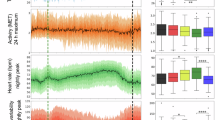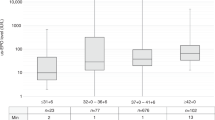Abstract
Oculo-auriculo-vertebral spectrum is a complex developmental disorder characterised mainly by anomalies of the ear, hemifacial microsomia, epibulbar dermoids and vertebral anomalies. The aetiology is largely unknown, and the epidemiological data are limited and inconsistent. We present the largest population-based epidemiological study to date, using data provided by the large network of congenital anomalies registries in Europe. The study population included infants diagnosed with oculo-auriculo-vertebral spectrum during the 1990–2009 period from 34 registries active in 16 European countries. Of the 355 infants diagnosed with oculo-auriculo-vertebral spectrum, there were 95.8% (340/355) live born, 0.8% (3/355) fetal deaths, 3.4% (12/355) terminations of pregnancy for fetal anomaly and 1.5% (5/340) neonatal deaths. In 18.9%, there was prenatal detection of anomaly/anomalies associated with oculo-auriculo-vertebral spectrum, 69.7% were diagnosed at birth, 3.9% in the first week of life and 6.1% within 1 year of life. Microtia (88.8%), hemifacial microsomia (49.0%) and ear tags (44.4%) were the most frequent anomalies, followed by atresia/stenosis of external auditory canal (25.1%), diverse vertebral (24.3%) and eye (24.3%) anomalies. There was a high rate (69.5%) of associated anomalies of other organs/systems. The most common were congenital heart defects present in 27.8% of patients. The prevalence of oculo-auriculo-vertebral spectrum, defined as microtia/ear anomalies and at least one major characteristic anomaly, was 3.8 per 100 000 births. Twinning, assisted reproductive techniques and maternal pre-pregnancy diabetes were confirmed as risk factors. The high rate of different associated anomalies points to the need of performing an early ultrasound screening in all infants born with this disorder.
Similar content being viewed by others
Log in or create a free account to read this content
Gain free access to this article, as well as selected content from this journal and more on nature.com
or
References
Goldenhar M : Associations malformatives de l’oeil et de l’oreille, en particulier le syndrome dermoïde epibulbaire-appendices auriculaires-fistula auris congenita et ses relations avec la dysostose mandibulo-faciale. J Genet Hum 1952; 1: 243–282.
Grabb WC : The first and second brachial arch syndromes. Plast Reconstr Surg 1965; 36: 485–508.
Hennekam RC, Krantz ID, Allanson JE : Gorlin's Syndromes of the Head and Neck. Oxford: Oxford University Press, 2010.
Rollnick BR, Kaye CI, Nagatoshi K, Hauck W, Martin AO : Oculoauriculovertebral dysplasia and variants: phenotypic characteristics of 294 patients. Am J Med Genet 1987; 26: 361–375.
Tasse C, Böhringer S, Fischer S et al: Oculo-auriculo-vertebral spectrum (OAVS): clinical evaluation and severity scoring of 53 patients and proposal for a new classification. Eur J Med Genet 2005; 48: 397–411.
Rooryck C, Souakri N, Cailley D et al: Array-CGH analysis of a cohort of 86 patients with oculoauriculovertebral spectrum. Am J Med Genet A 2010; 152A: 1984–1989.
Brun A, Cailley D, Toutain J et al: 1.5 Mb microdeletion in 15q24 in a patient with mild OAVS phenotype. Eur J Med Genet 2012; 55: 135–139.
Ou Z, Martin DM, Bedoyan JK et al: Branchiootorenal syndrome and oculoauriculovertebral spectrum features associated with duplication of SIX1, SIX6, and OTX2 resulting from a complex chromosomal rearrangement. Am J Med Genet A 2008; 146A: 2480–2489.
Northup JK, Matalon D, Hawkins JC et al: Pericentric inversion, inv(14)(p11.2q22.3), in a 9-month old with features of Goldenhar syndrome. Clin Dysmorphol 2010; 19: 185–189.
Ballesta-Martínez MJ, López-González V, Dulcet LA, Rodríguez-Santiago B, Garcia-Miñaúr S, Guillen-Navarro E : Autosomal dominant oculoauriculovertebral spectrum and 14q23.1 microduplication. Am J Med Genet A. 2013; 161: 2030–2035.
Kelberman D, Tyson J, Chandler DC et al: Hemifacial microsomia: progress in understanding the genetic basis of a complex malformation syndrome. Hum Genet 2001; 109: 638–645.
Huang XS, Li X, Tan C et al: Genome-wide scanning reveals complex etiology of oculo-auriculo-vertebral spectrum. Tohoku J Exp Med 2010; 222: 311–318.
Fischer S, Lüdecke HJ, Wieczorek D, Böhringer S, Gillessen-Kaesbach G, Horsthemke B : Histone acetylation dependent allelic expression imbalance of BAPX1 in patients with the oculo-auriculo-vertebral spectrum. Hum Mol Genet 2006; 15: 581–587.
Wieczorek D, Ludwig M, Boehringer S, Jongbloet PH, Gillessen-Kaesbach G, Horsthemke B : Reproduction abnormalities and twin pregnancies in parents of sporadic patients with oculo-auriculo-vertebral spectrum/Goldenhar syndrome. Hum Genet 2007; 121: 369–376.
Stoll C, Viville B, Treisser A, Gasser B : A family with dominant oculoauriculovertebral spectrum. Am J Med Genet 1998; 78: 345–349.
Tasse C, Majewski F, Böhringer S et al: A family with autosomal dominant oculo-auriculo-vertebral spectrum. Clin Dysmorphol 2007; 16: 1–7.
Krause U : The syndrome of Goldenhar affecting two siblings. Acta Ophthalmol 1970; 48: 494–469.
Lacombe D, Battin J : Germinal mosaicism in oculo-auriculo-vertebral dysplasia? Am J Med Genet 1993; 46: 609–610.
Werler MM, Starr JR, Cloonan YK, Speltz ML : Hemifacial microsomia: from gestation to childhood. J Craniofac Surg Suppl 2009; 20: 664–669.
Lessick M, Vasa R, Israel J : Severe manifestations of oculoauriculovertebral spectrum in a cocaine exposed infant. J Med Genet 1991; 28: 803–804.
Poswillo D : The pathogenesis of the first and second branchial arch syndrome. Oral Surg 1973; 35: 302–329.
Lawson K, Waterhouse N, Gault DT, Calvert ML, Botma M, Ng R : Is hemifacial microsomia linked to multiple maternities? Br J Plast Surg 2002; 55: 474–478.
Werler MM, Sheehan JE, Hayes C, Padwa BL, Mitchell AA, Mulliken JB : Demographic and reproductive factors associated with hemifacial microsomia. Cleft Palate Craniofac J 2004; 41: 494–550.
Jongbloet PH : Goldenhar syndrome and overlapping dysplasias, in vitro fertilisation and ovopathy. J Med Genet 1987; 24: 616–620.
Wang R, Martínez-Frías ML, Graham JM Jr : Infants of diabetic mothers are at increased risk for the oculo-auriculo-vertebral sequence: a case-based and case-control approach. J Pediatr 2002; 141: 611–617.
Morrison PJ, Mulholland HC, Craig BG, Nevin NC : Cardiovascular abnormalities in the oculo-auriculo-vertebral spectrum (Goldenhar syndrome). Am J Med Genet 1992; 44: 425–428.
Boyd PA, Haeusler M, Barisic I, Loane M, Garne E, Dolk H : Paper 1: The EUROCAT network-organization and processes. Birth Defects Res A Clin Mol Teratol 2011; 91 (Suppl1):: S2–15.
Vento AR, LaBrie RA, Mulliken JB : The O.M.E.N.S. classification of hemifacial microsomia. Cleft Palate Craniofac J 1991; 28: 68–76.
Touliatou V, Fryssira H, Mavrou A, Kanavakis E, Kitsiou-Tzeli S : Clinical manifestations in 17 Greek patients with Goldenhar syndrome. Genet Couns 2006; 17: 359–370.
Araneta MR, Moore CA, Olney RS et al: Goldenhar syndrome among infants born in military hospitals to Gulf War veterans. Teratology 1997; 56: 244–251.
Stoll C, Roth MP, Dott B, Bigel P : Discordance for skeletal and cardiac defect in monozygotic twins. Acta Genet Med Gemellol 1984; 33: 501–504.
Melnick M : Hereditary hearing loss and ear dysplasia-renal adysplasia syndromes: syndrome delineation and possible pathogenesis. Birth Defects Orig Artic Ser 1980; 16: 59–72.
Gibson JN, Sillence DO, Taylor TK : Abnormalities of the spine in Goldenhar's syndrome. J Pediatr Orthop 1996; 16: 344–349.
Digilio MC, Calzolari F, Capolino R et al: Congenital heart defects in patients with oculo-auriculo-vertebral spectrum (Goldenhar syndrome). Am J Med Genet A 2008; 146A: 1815–1819.
Greenwood RD, Rosenthal A, Sommer A, Wolff G, Craenen J : Cardiovascular malformations in oculoauriculovertebral dysplasia (Goldenhar syndrome). J Pediatr 1974; 85: 816–818.
Kumar A, Friedman JM, Taylor GP, Patterson MW : Pattern of cardiac malformation in oculoauriculovertebral spectrum. Am J Med Genet 1993; 46: 423–426.
Ritchey ML, Norbeck J, Huang C, Keating MA, Bloom DA : Urologic manifestations of Goldenhar syndrome. Urology 1994; 43: 88–91.
Rosa RF, Graziadio C, Lenhardt R, Alves RP, Paskulin GA, Zen PR : Central nervous system abnormalities in patients with oculo-auriculo-vertebral spectrum (Goldenhar syndrome). Arq Neuropsiquiatr 2010; 68: 98–102.
Gabbett MT, Robertson SP, Broadbent R, Aftimos S, Sachdev R, Nezarati MM : Characterizing the oculoauriculofrontonasal syndrome. Clin Dysmorph 2008; 17: 79–85.
Evans KN, Gruss JS, Khanna PC, Cunningham ML, Cox TC, Hing AV : Oculoauriculofrontonasal syndrome: case series revealing new bony nasal anomalies in an old syndrome. Am J Med Genet A 2013; 161: 1345–1353.
Bergmann C, Zerres K, Peschgens T, Senderek J, Hörnchen H, Rudnik-Schöneborn S : Overlap between VACTERL and hemifacial microsomia illustrating a spectrum of malformations seen in axial mesodermal dysplasia complex (AMDC). Am J Med Genet A 2003; 121A: 151–155.
Castori M, Brancati F, Rinaldi R et al: Antenatal presentation of the oculo-auriculo-vertebral spectrum (OAVS). Am J Med Genet A 2006; 140: 1573–1579.
Kushnick T, Colondrillo M : 49, XXXXY patient with hemifacial microsomia. Clin Genet 1975; 7: 442–448.
Rao VA, Kaliaperumal S, Subramanyan T, Rao KR, Bhargavan R : Goldenhar's sequence with associated juvenile glaucoma in Turner's syndrome. Indian J Ophthalmol 2005; 53: 267–268.
Pison G, D'Addato AV : Frequency of twin births in developed countries. Twin Res Hum Genet 2006; 9: 250–259.
de Mouzon J, Goossens V, Bhattacharya S et al: European IVF-Monitoring (EIM); Consortium for the European Society on Human Reproduction and Embryology (ESHRE). Assisted reproductive technology in Europe, 2007: results generated from European registers by ESHRE. Hum Reprod 2012; 27: 954–966.
Ferraris S, Silengo M, Ponzone A, Perugini L : Goldenhar anomaly in one of triplets derived from in vitro fertilization. Am J Med Genet 1999; 84: 167–168.
Roesch C, Steinbicker V, Korb C, von Rohden L, Schmitt J : Goldenhar anomaly in one triplet derived from intracytoplasmic sperm injection (ICSI). Am J Med Genet 2001; 101: 82–83.
Gittins V, Kasraie J : Case report: Goldenhar syndrome following donor oocyte IVF. J Assist Reprod Genet 2010; 27: 561–563.
Boyle B, McConkey R, Garne E et al: Trends in the prevalence, risk and pregnancy outcome of multiple births with congenital anomaly: a registry-based study in 14 European countries 1984-2007. BJOG 2013; 120: 707–716.
Garne E, Loane M, Dolk H et al: Spectrum of congenital anomalies in pregnancies with pregestational diabetes. Birth Defects Res A Clin Mol Teratol 2012; 94: 134–140.
Acknowledgements
This study is a part of the EUROCAT Joint Action funded by the EC, under the framework of EU Health Programme 2008–2013, Grant Agreement 20102204 (Executive Agency for Health and Consumers). We thank Dr Elizabeth S Draper, Dr Miriam Gatt, Dr Martin Haeusler, Dr Anna Latos-Bielenska, Dr Christine Verellen-Dumoulin, Dr Carlos Matias Dias, Dr Vera Nelen and Dr Mary ÓMahony for providing data for the present study. We also thank the many people throughout Europe involved in providing and processing information, including affected families, clinicians, health professionals, medical record clerks and registry staff.
Author information
Authors and Affiliations
Corresponding author
Ethics declarations
Competing interests
The authors declare no conflict of interest.
Rights and permissions
About this article
Cite this article
Barisic, I., Odak, L., Loane, M. et al. Prevalence, prenatal diagnosis and clinical features of oculo-auriculo-vertebral spectrum: a registry-based study in Europe. Eur J Hum Genet 22, 1026–1033 (2014). https://doi.org/10.1038/ejhg.2013.287
Received:
Revised:
Accepted:
Published:
Issue date:
DOI: https://doi.org/10.1038/ejhg.2013.287
Keywords
This article is cited by
-
Kraniofaziale Mikrosomie
Die MKG-Chirurgie (2023)
-
Association between craniofacial anomalies, intellectual disability and autism spectrum disorder: Western Australian population-based study
Pediatric Research (2022)
-
A recurrent missense variant in EYA3 gene is associated with oculo-auriculo-vertebral spectrum
Human Genetics (2021)
-
Prenatal retinoic acid exposure reveals candidate genes for craniofacial disorders
Scientific Reports (2018)
-
EUROCAT: an update on its functions and activities
Journal of Community Genetics (2018)



